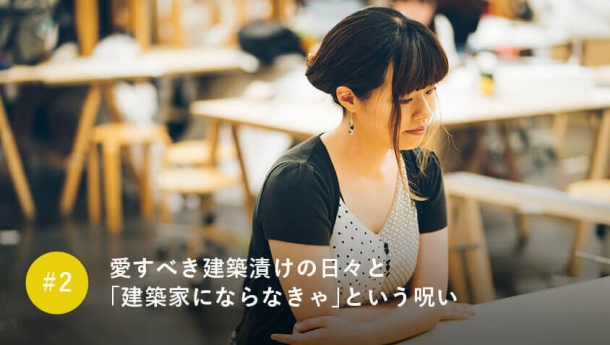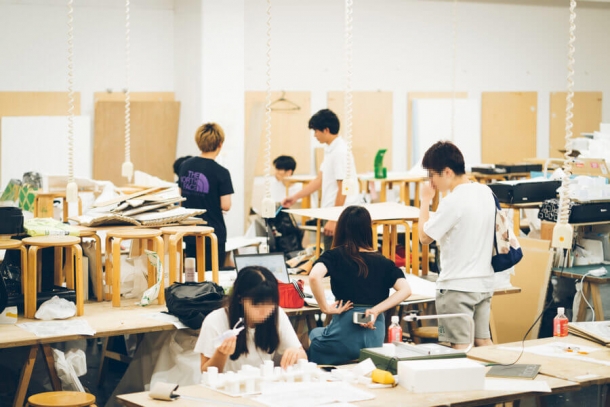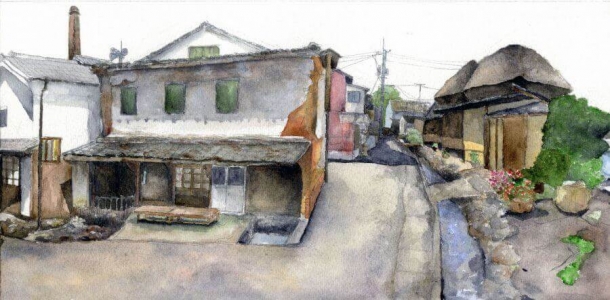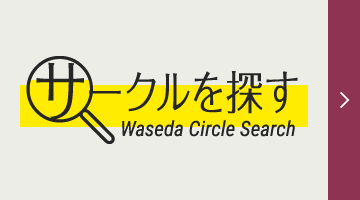
#2 Days Soaked in Beloved Architecture, and the Curse of “Needing to Become an Architect”
Q. Your study of architecture at university appears to have played an important role in your sento illustrations. How did you first become interested in architecture?
Enya
My mom works as an interior coordinator, and when I was in junior high she taught me how to draw a room’s interior using perspective methods. That’s how I first became interested in architecture. In high school, when considering what field I wanted to pursue after graduating, I decided on architecture because it incorporated math, physics, philosophy, and art — all things I liked at the time.
I attended open campuses for a number of universities. While other universities had prepared proper models and nice posters, Waseda just had a shabbily placed graphite architectural drawing. The “heat” emanating from that raw presentation inspired me to enter Waseda.
 Caption: The architectural design studio in the basement of Building 57 on Nishiwaseda Campus. Enya recalls she “practically living there” as a student. We saw many students working on projects there when we visited for this interview.
Caption: The architectural design studio in the basement of Building 57 on Nishiwaseda Campus. Enya recalls she “practically living there” as a student. We saw many students working on projects there when we visited for this interview.
Q. So you were drawn to Waseda by that “heat.” [laughs] How did you spend your days as a student?
Enya
From morning to night, my days were soaked in architecture. There were days I didn’t go home, when I spent the night at the architectural design studio to work on projects. On other days, even when I didn’t have any projects to work on, I talked about design with friends into the early hours of the morning. Working all night was fun. My part-time job was creating architectural models, and I was in Perspective Kenkyu-kai, a club that focused on visiting architectural works. It was six years of thinking about nothing but architecture.
Q. It sounds like a very engrossing period.
Enya
It was fun. I was completely immersed. I wrote my thesis on “cities’ colors,” focusing on the city of Kashima in Saga Prefecture. Each city has its own colors that form its identity. I spent half a month in Kashima, during which time I drew 20 pages of sketches and two three-meter picture scrolls.

Caption: A water painting of the cityscape of Kashima, Saga Prefecture, drawn by Enya for her graduation thesis.
When I showed them to locals, they replied, “Wow! I had no idea our city was such a great place!”
I didn’t think my drawings were anything special, but when I received that reaction for the first time, I felt the inherent value of drawings. That’s when I decided to apply myself to drawing, which is something I’ve enjoyed since I was little.
But I wasn’t interested in becoming a painter; I wanted to create drawings related to my study of architecture. So, as a graduate student, I studied with the goal of fusing drawing and architecture.
Q. It seems that goal of combining drawing and architecture was a big part of what led to your sento illustrations.
Enya
Yes. But back then I wasn’t able to accomplish that goal. The theme of my research compilation for my master’s design was the design of the Ginza metro station. I conducted field work from Ueno to Asakusa and incorporated designs into my sketches.
When I presented my work, my teachers said, “The sketches are nice, but the designs are all wrong.” I entered the two-year graduate program because I wanted to apply myself to design, so it was very disheartening to receive that reaction. I felt I needed to redeem myself, and that the only way to do that was to study under an architect and learn how to fuse drawing and design. That’s why I jumped head first into a job at a design office. Looking back, part of the reason I stuck with design was probably to rid myself of that feeling of defeat.
Q. But then you had a physical breakdown and encountered sento.
Enya
I’ve always hated losing, and because I had wanted to become an architect since junior high school, I got completely absorbed by my job, to the point that it destroyed my health. I took a leave of absence from work, but after I encountered sento and recovered, I decided to return to work and give it another try. But I couldn’t move my body like before, which created all sorts of obstacles. That’s when Yusuke Hiramatsu, the young owner of Kosugiyu sento, asked me if I wanted to try working there.
Q. It must have been an excruciating decision to quit your job at the design office, considering your intimate connection to architecture since entering university.
Enya
I was very conflicted. Continuing to work at the design office would have been tough, but, on the other hand, choosing Kosugiyu sento would have meant wasting everything I had gruelingly worked for, and killing my dream to become an architect, a dream I had since junior high school. I felt that quitting architecture was tantamount to rejecting who I was.

I had a very hard time coming to a decision, and so I consulted with my friends. They suggested changing jobs, saying, “After all, it’s drawing that’s been important to you,” and, “You can do architecture whenever, so take the path that’s open in front of you.”
Q. Your friends had observed you for a long time, so they were able to see things that you couldn’t.
Enya
I think so. Looking back, I realize I had kept saying to myself, “I need to become an architect, I need to do architecture,” but had no vision of what kind of architecture I wanted to create, or what kind of architect I wanted to be.
Whether it be what I did at university, the poor reaction I received from teachers in response to my master’s design, or my lackluster grades, these were all things that pushed me hard. But at some point, this idea of “needing to become an architect” turned into a curse. The notion that I was not good enough and that’s why I needed to push harder was a form of self-denial.
For these reasons, I immediately felt relieved when I decided to quit architecture.
#3 The Conflict Between “What I Want to Be” and “How I Want to Be,” and Arriving at One’s Path



